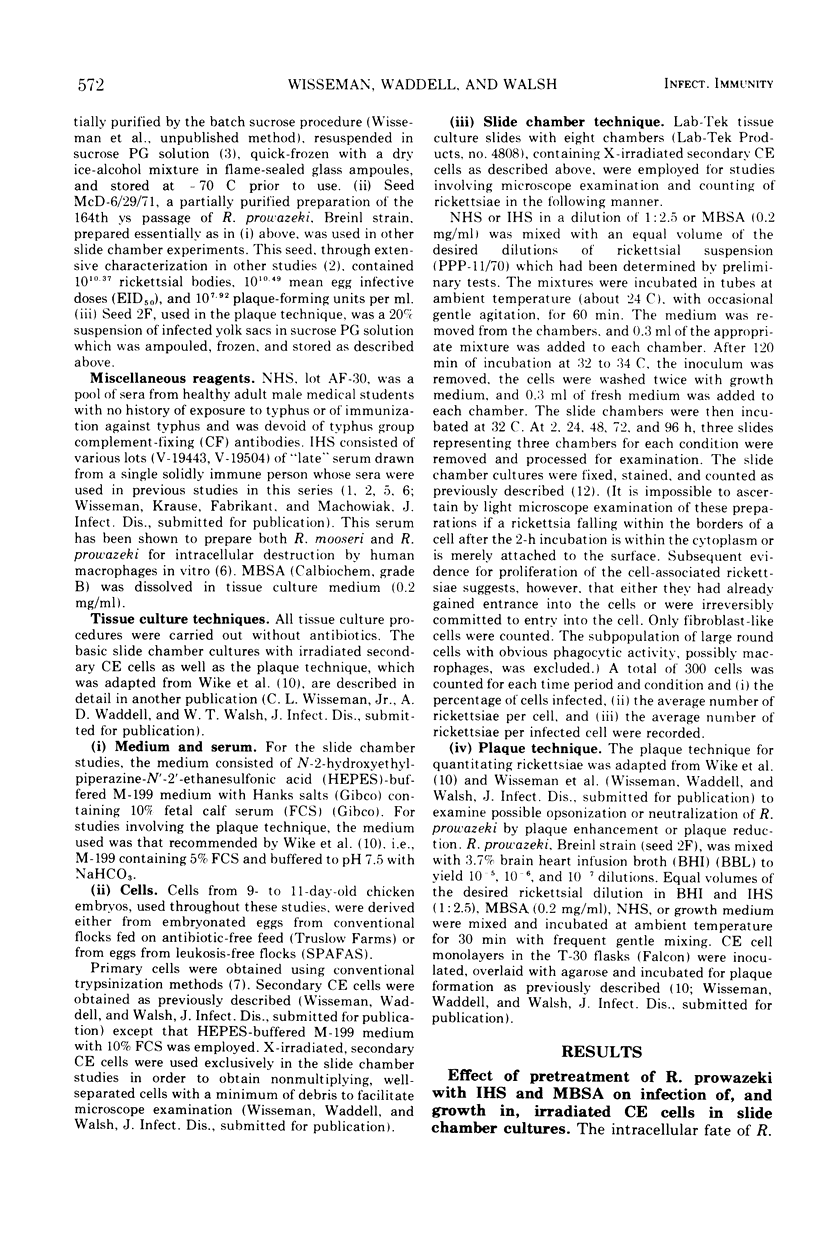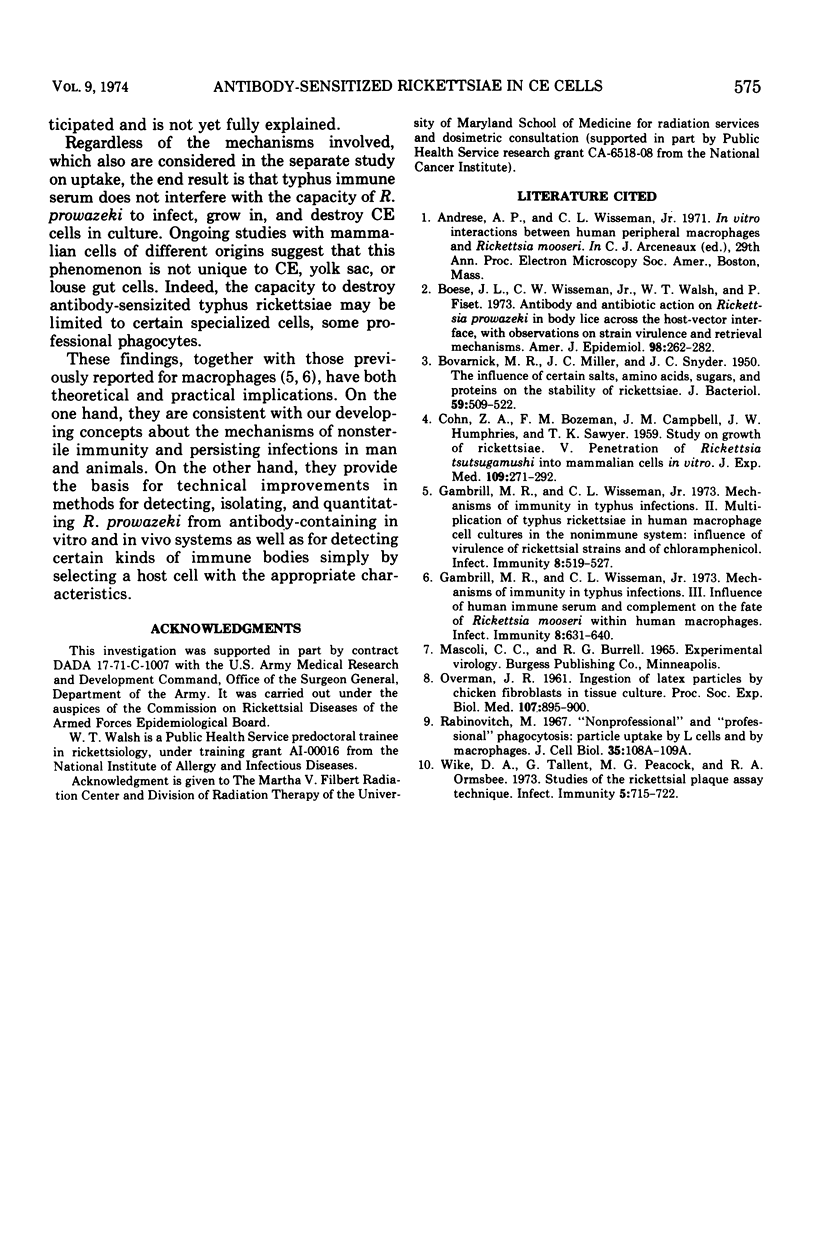Abstract
Rickettsia prowazeki, pretreated with typhus immune human serum, readily infects, and grows in, chicken embryo cells in culture. This finding is similar to those of previous studies which showed that typhus rickettsiae, pretreated with immune serum, grow in cells of the yolk sac of embryonated hen eggs and in the cells of the midgut of the human body louse. In contrast, identically treated typhus rickettsiae were destroyed by human macrophages in culture. Collectively, these observations seem to support an emerging concept that the fate of antibody-sensitized typhus rickettsiae depends upon the presence or absence of certain specialized properties of the host cell into which they gain entrance—nonphagocytic cells or “nonprofessional” phagocytic cells versus certain kinds of “professional” phagocytes. The phenomena involved probably have an important bearing on the mechanisms of the persisting infection and the nonsterile immunity which characterizes convalescence from typhus fever in man. They also form the basis for certain practical technical innovations in the laboratory.
Full text
PDF




Selected References
These references are in PubMed. This may not be the complete list of references from this article.
- BOVARNICK M. R., MILLER J. C., SNYDER J. C. The influence of certain salts, amino acids, sugars, and proteins on the stability of rickettsiae. J Bacteriol. 1950 Apr;59(4):509–522. doi: 10.1128/jb.59.4.509-522.1950. [DOI] [PMC free article] [PubMed] [Google Scholar]
- Boese J. L., Wisseman C. L., Jr, Walsh W. T., Fiset P. Antibody and antibiotic action on Rickettsia prowazeki in body lice across the host-vector interface, with observations on strain virulence and retrieval mechanisms. Am J Epidemiol. 1973 Oct;98(4):262–282. doi: 10.1093/oxfordjournals.aje.a121556. [DOI] [PubMed] [Google Scholar]
- COHN Z. A., BOZEMAN F. M., CAMPBELL J. M., HUMPHRIES J. W., SAWYER T. K. Study on growth of Rickettsia. V. Penetration of Rickettsia tsutsugamushi into mammalian cells in vitro. J Exp Med. 1959 Mar 1;109(3):271–292. doi: 10.1084/jem.109.3.271. [DOI] [PMC free article] [PubMed] [Google Scholar]
- Gambrill M. R., Wisseman C. L., Jr Mechanisms of immunity in typhus infections. 3. Influence of human immune serum and complement on the fate of Rickettsia mooseri within the human macrophages. Infect Immun. 1973 Oct;8(4):631–640. doi: 10.1128/iai.8.4.631-640.1973. [DOI] [PMC free article] [PubMed] [Google Scholar]
- Gambrill M. R., Wisseman C. L., Jr Mechanisms of immunity in typhus infections. I. Multiplication of typhus rickettsiae in human macrophage cell cultures in the nonimmune system: influence of virulence of rickettsial strains and of chloramphenicol. Infect Immun. 1973 Oct;8(4):519–527. doi: 10.1128/iai.8.4.519-527.1973. [DOI] [PMC free article] [PubMed] [Google Scholar]
- OVERMAN J. R. Ingestion of latex particles by chicken fibroblasts in tissue culture. Proc Soc Exp Biol Med. 1961 Aug-Sep;107:895–900. doi: 10.3181/00379727-107-26788. [DOI] [PubMed] [Google Scholar]
- Wike D. A., Tallent G., Peacock M. G., Ormsbee R. A. Studies of the rickettsial plaque assay technique. Infect Immun. 1972 May;5(5):715–722. doi: 10.1128/iai.5.5.715-722.1972. [DOI] [PMC free article] [PubMed] [Google Scholar]


